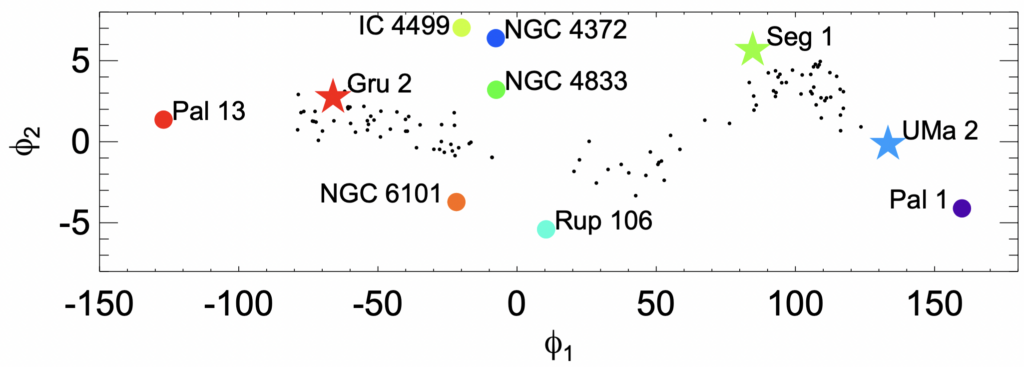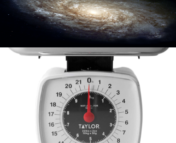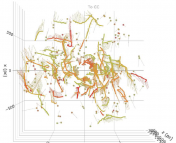Title: Piercing the Milky Way: an all-sky view of the Orphan Stream
Authors: Sergey Koposov, Vasily Belokurov, Ting Li, et al.
First Author’s Institution: Carnegie Mellon University, Pittsburgh, PA, USA; Institute of Astronomy, University of Cambridge, UK
Status: Published in Monthly Notices of the Royal Astronomical Society [closed access]

We all have (perhaps) fond memories of early childhood mishaps, such as falling off our bikes or taking a tumble in the playground. You might be surprised to find that galaxies share in this experience, visibly bearing the scars of their playful past. Of course, it’s difficult to have a conversation with a galaxy to hear the stories that accompany these galactic scrapes and bruises, but analyzing stellar streams gives us a close approximation.
Stellar streams, such as those depicted in Figure 1, are groups of stars that are stretched out by interactions between their original host (a smaller, dwarf galaxy or globular cluster, for example) and a large galaxy, such as the Milky Way. Because the shapes of these arches are a direct by-product of gravitational interactions, streams are a powerful probe of the structure of a galaxy’s gravitational field (e.g. they might point us to where the dark matter is) and they spin the tale of their original host’s tumultuous past. Specifically, along a satellite galaxy’s close passage to the larger galaxy, the orbits of stars from the passing satellite will be slightly perturbed (by the gravitational pull of the big galaxy), such that a few are left behind at every step on the way. This results in a visible tracer of the satellite’s path and makes for some beautiful images (just look at Figure 1!). Using a class of periodic variable stars known as RR Lyrae stars to probe the shape of the stream, the authors of today’s paper have taken a deep dive into understanding one of the first discovered stellar streams – the aptly named “Orphan Stream” – observed in the halo of the Milky Way, with the hopes of uncovering some information as to which cosmic neighbor lost those stars along the way.
Selecting Stars to Analyze
This stellar stream passes close to the Galactic center, which introduces a big problem: it’s very crowded there, making it difficult to pick out individual stars, especially those belonging to the stream. Deep imaging, along with highly precise measurements of the velocities of stars in the stream, help us identify the path on which they’re headed (and, by proxy, tell us from where they came). In this regard, the observations made by Gaia are indispensable and have provided us with an incredible volume of data coupled with an unprecedented level of astrometric (position and motion based-) precision for stars in the Milky Way over the last few years. Despite years of efforts to identify the full extent of the Orphan Stream and, in doing so, hopefully connect its structure to a possible parent, a confident identification of such data was elusive until today’s paper.
Analyzing the Stream
Today’s authors took advantage of the second data release (DR2) of the Gaia satellite. Specifically, they used the extensive catalog of RR Lyrae (RRL) pulsating variable stars – common members of the cosmic distance ladder because of a well-understood relationship between their brightness and the period of their pulsations – to map out the Orphan Stream above and below the Galactic plane (Figure 2). They were able to identify the positions of stars in the stream and deviations from the standard stream direction by rotating to a coordinate system oriented with the stream’s extent. In other words, we can tilt our heads (or our plots) such that the spread of stars in the Orphan Stream’s arch populates the horizontal axis. By doing this, they were able to observe the full extent of the Orphan Stream and locate a previously-unseen southern (below the Galactic plane) component to the arch (Figure 2)!

In this tilted coordinate system and with the Gaia velocity data, they also saw that there are stars moving across the stream in certain regions. In general, we expect that the stars in an unbothered stream move along the direction of the arch (e.g. along the arrow directions in Figure 2), so the finding here – seeing that the southern stars are actually also moving across the stream – indicates an interaction with some sort of massive body relatively recently after the stream formed.
RR Lyrae stars can be categorized into two types based on their periods. Observationally, it has been found that globular clusters either have one type or the other, but not both. Therefore, by classifying the stars in today’s study by their periods, the authors were able to speculate that these stars more likely originated in a dwarf galaxy than a globular cluster. In fact, they used the frequency of observed RRL stars to estimate the brightness of the Orphan’s lost parent and find that it is right in line with the luminosity of a classical dwarf galaxy. Indeed, returning to our coordinate system tilted with the stream and comparing the positions of the positions of several nearby globular clusters and dwarf galaxies to that of the stream (Figure 3), we can see that one ultra-faint dwarf, Gru 2, is both relatively nearby and is moving along with the stream!

Identifying the parentage of the Orphan Stream is clearly not an easy task and confirming it will require follow-up measurements of the chemical abundances and velocities of stars in dwarf galaxies such as Gru 2, but studies like today’s paper bring us one step closer to pinpointing just that and, more broadly, understanding the complex processes that have brought our galaxy to where it is today.
Astrobite edited by Lynnie Saade and Haley Wahl
Featured image credit: Wikipedia





you don’t inform us of three things
from your observation
did you discover the orphan stream in the inner milky way galactic halo
or
did you discover the orphan stream in the outer milky way galactic halo
from your velocity of the stream no first contact time given
the orphan stream seems to have entered the galactic disc 120 million years ago in the northern galactic plane close to Entry of orphan stream satellite to milky way via pal 1 uma2 seg 1 above the northern galactic plane
from your discovery that this first impact was met with a second drifter impact
which of these pal 1 uma2 or seg 1 might have drifted them orphan stars sideways
row row row your boat gently down the stream merrily merrily merrily galaxy life is so real